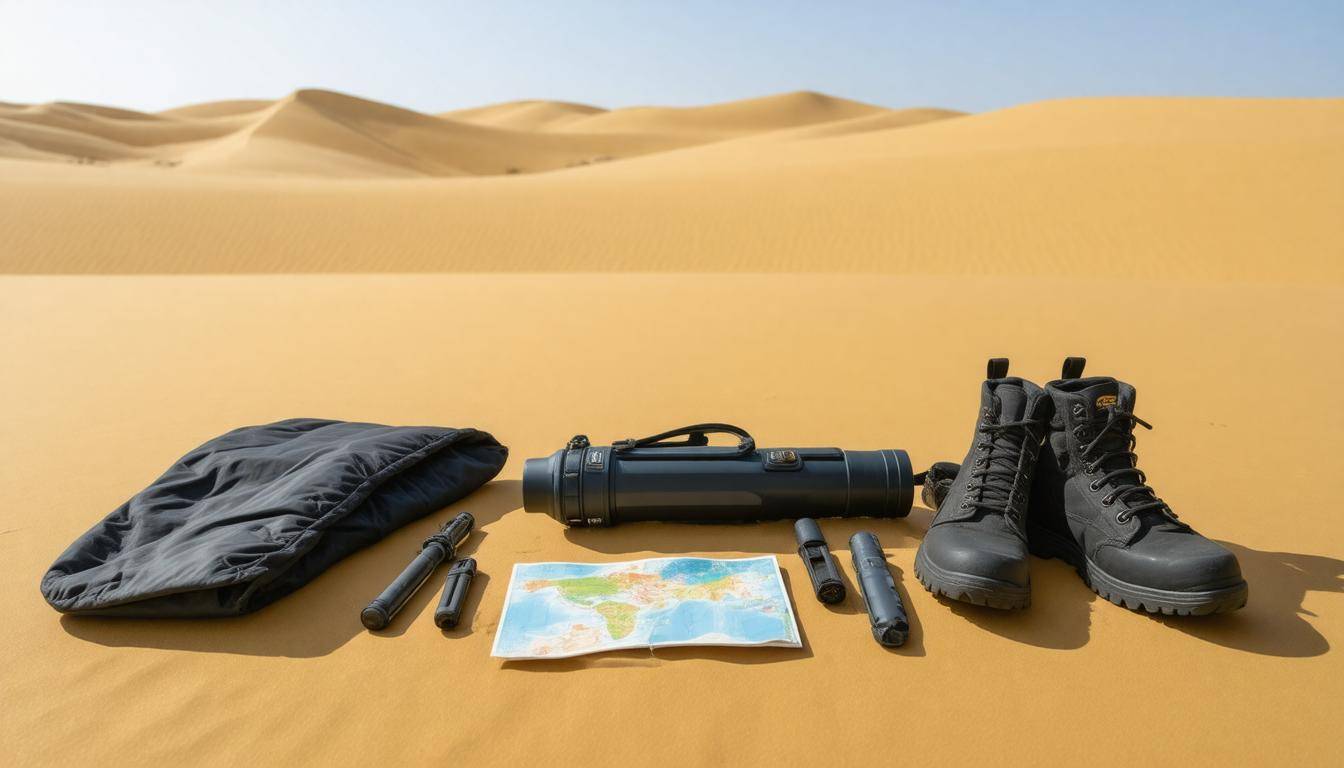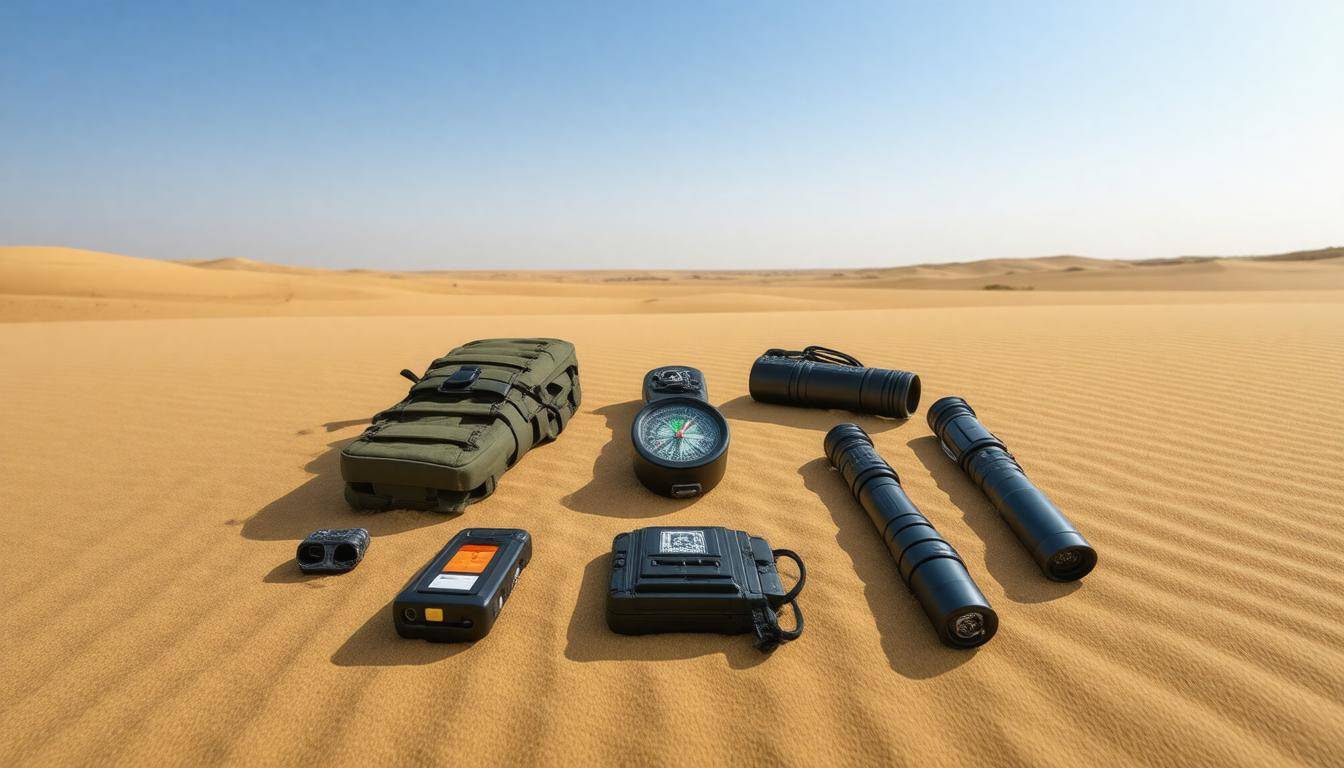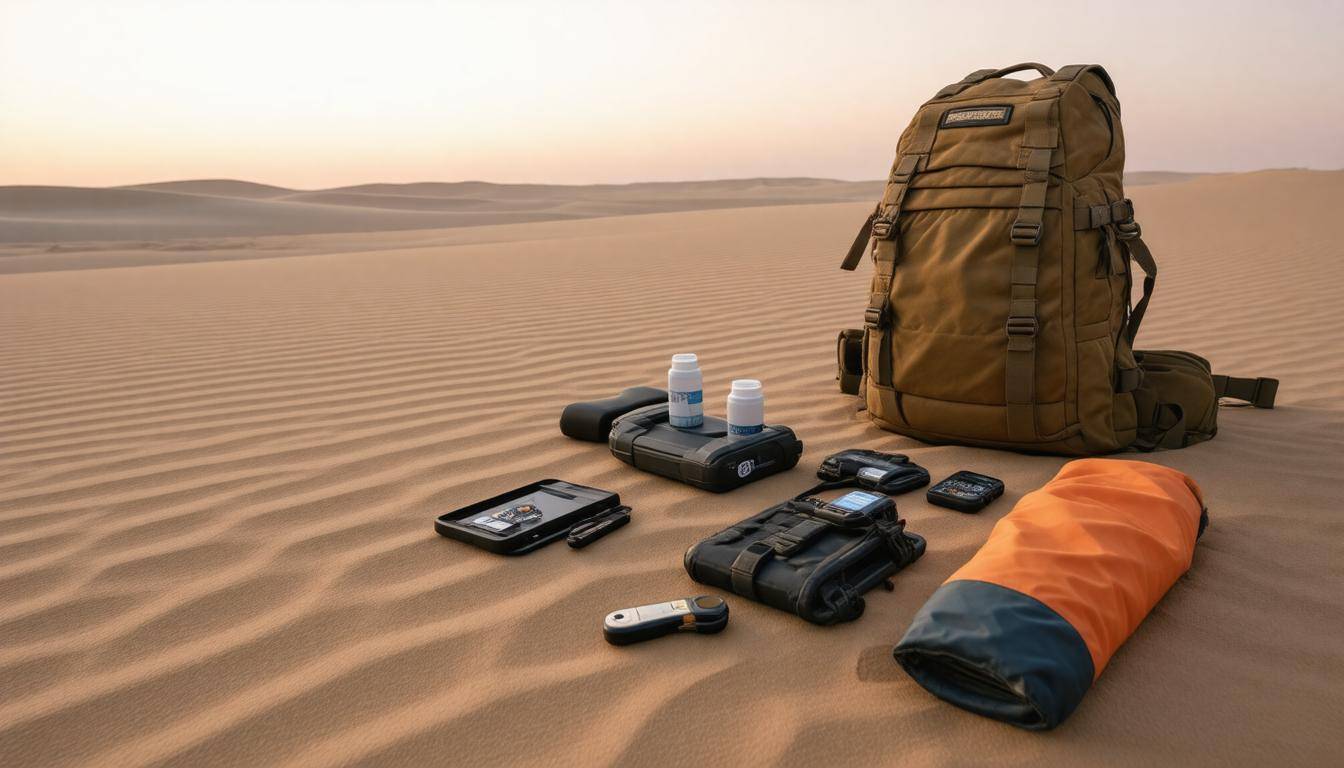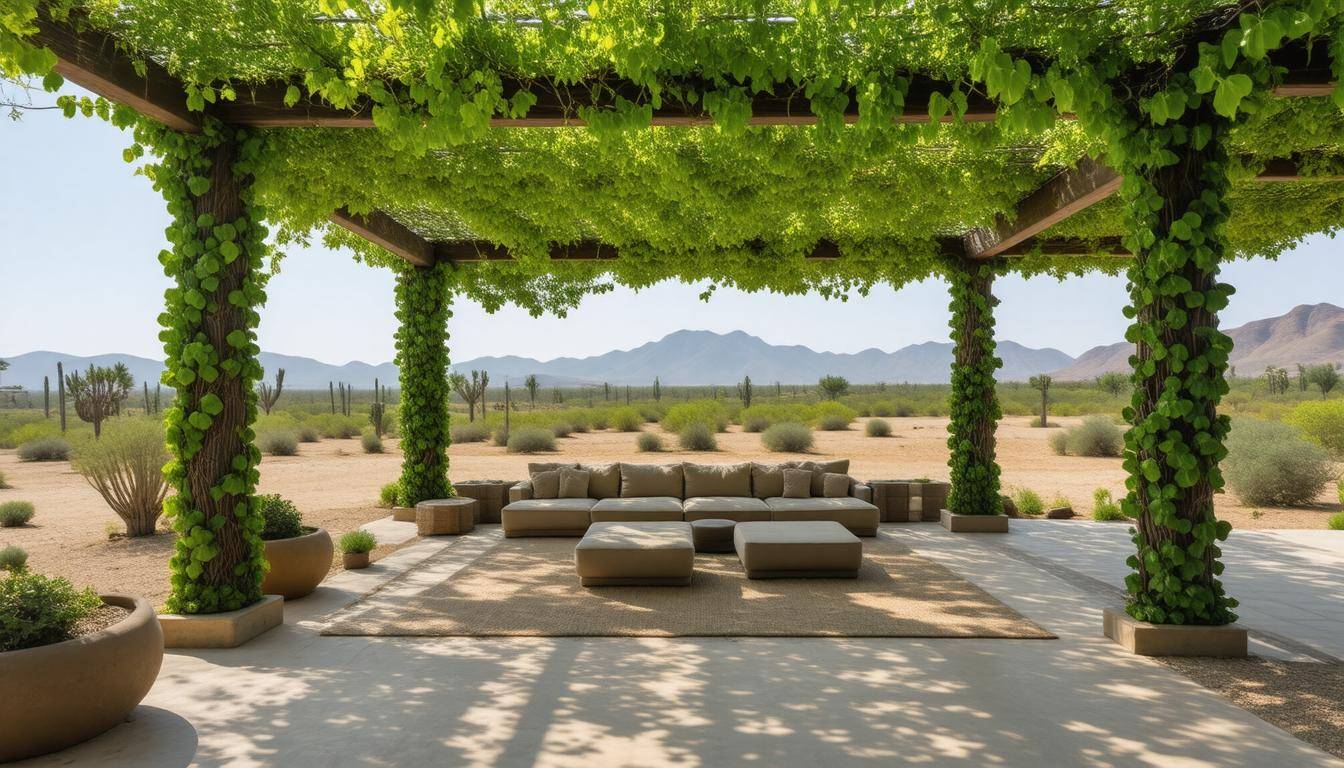Planning a trip to the Libyan desert can feel like stepping into an adventure movie—vast dunes, unending sun, and the thrill of survival. But it’s crucial to realize that the beautiful landscapes come with significant challenges. From finding clean water to protecting yourself from relentless heat, every detail counts in ensuring not just comfort, but survival. I’ve spent countless hours researching and experiencing this incredible terrain firsthand, uncovering what works and what doesn’t when it comes to staying safe out there. In this guide, you’ll find essential tips and gear recommendations that will prepare you for the demanding conditions of the Libya desert, allowing you to enjoy the breathtaking scenery without compromising your well-being. So pack your bags and let’s dive into everything you need to know before hitting those sandy paths!
Essential survival items for the Libya Desert include a reliable source of water, sun protection such as wide-brimmed hats and sunscreen, a first aid kit, navigation tools like maps or GPS devices, and sturdy footwear. Additionally, carrying non-perishable food, a multi-tool for various tasks, shelter materials, and signaling devices can significantly enhance your chances of surviving in this harsh environment.

Essential Libya Desert Gear
When adventurers think about the Libyan desert, they often picture endless dunes and scorching sunlight. However, it is crucial to equip themselves with specialized gear designed to withstand this harsh environment. This isn’t just a guideline; it’s a matter of life and death. Having the right gear can greatly enhance your chances of surviving and thriving in such extreme conditions.
Multi-purpose Tools
A multi-tool like the Leatherman Wave isn’t just a gadget; it’s your best ally in the desert. You might need to cut through tough materials, saw wood for a fire, or even open food cans—tasks made infinitely easier with a good multi-tool in hand. In emergencies, you can perform minor repairs on other equipment, ensuring that a small issue doesn’t escalate into a more significant problem. Consider packability as well; having one reliable tool minimizes weight while maximizing functionality.
Hydration Systems
Staying hydrated is non-negotiable in the desert. Advanced hydration systems, such as those offered by CamelBak, are invaluable due to their large capacity—up to 3 liters—allowing you to stay refreshed during long treks. However, it’s not enough to rely solely on these systems; carrying additional water bladders as backups is advisable. Always remember that your survival depends largely on maintaining proper hydration levels—set reminders to drink regularly!
Shelter
When it comes to shelter, lightweight and durable tents become essential during your desert journey. Opting for something like the ALPS Mountaineering Tasmanian 2-Person Tent can be a game changer. This type of tent incorporates reflective material designed specifically to fend off the blazing sun’s rays. Without adequate shelter from both heat and wind, you risk suffering from heat exhaustion or exposure during frigid nights. Crafting a shaded area becomes critical not just for comfort but for survival.
After choosing your essential gear, understanding how to dress appropriately for the extreme temperatures becomes equally paramount in your adventure preparation.
Clothing for Extreme Heat
The right clothing can truly make a significant difference when navigating the blistering temperatures of the desert, where mercury levels can soar above 130°F (54°C). Consider lightweight and breathable fabrics, such as cotton or linen, which allow air circulation while helping to wick away moisture from your skin. These materials not only keep you cool but also play an essential role in maintaining your body temperature. Interestingly, wearing loose-fitting garments can help reduce your body temperature by as much as 5 degrees Celsius compared to tight options; this is because loose clothes promote airflow and prevent sweat from clinging to your skin.
Opting for specific brands like Columbia and Patagonia is a smart move, as they offer specialized outdoor attire designed specifically for harsh climates that include built-in UV protection. Look for items with a UPF rating of at least 30—this ensures that you have a good defense against harmful sun rays, shielding your skin effectively.
A layering strategy is another crucial element to consider when dressing for the desert. Start with a moisture-wicking inner layer that will help keep sweat off your skin, followed by an insulating middle layer to trap some heat during cooler nights. Finally, top it off with a protective outer layer that guards against wind and sandstorms. This three-layer approach ensures you are prepared for the temperature fluctuations that frequently occur between day and night in the desert.
Headgear cannot be overlooked either. A wide-brimmed hat can provide excellent protection for your face and neck from the relentless sun, while items like a shemagh not only serve to shield against UV exposure but add versatility; soaking them in water offers a surprisingly effective cooling method. By wrapping one around your neck or head, you create evapotranspiration that cools you down significantly.
As you think about what to wear, remember that layering wisely and choosing appropriate fabrics goes hand in hand with preparing other essentials needed along your journey through the striking landscapes of the Libyan desert.
Backpacks and Protective Gear
When preparing for a journey through the harsh and unforgiving landscape of the desert, selecting the right backpack and protective gear becomes your lifeline. Start with an ergonomic backpack that fits comfortably against your body; the Osprey Atmos AG 65 is a prime choice because of its incredible design that features a suspended mesh back panel, allowing air to flow while minimizing sweat accumulation. A properly fitted pack must not exceed 15% of your body weight for optimal comfort, ensuring stability even when you’re navigating rocky trails or shifting sands.
Make sure you choose a backpack with ample storage space and adjustability features that suit your body shape perfectly. Look for padded shoulder straps and hip belts that redistribute weight effectively, keeping you light on your feet while traversing uneven terrain—an essential factor when hiking long distances under the intense sun.
Furthermore, consider packing smartly; utilize compartments wisely to maximize accessibility while reducing the chaos inside.
Protective Gear
Now let’s explore protective gear. Think of gaiters as your first line of defense against fine grains of sand sneaking into your boots. These durable fabric shields wrap around your lower legs, preventing debris from getting in while providing additional moisture resistance. This is especially vital when you’re out there walking for hours, as gritty sand can become quite uncomfortable over time.
In addition to gaiters, knee and elbow pads are worth considering as they provide cushioning and protection when navigating rocky terrains. Be sure to select items made from breathable material to avoid overheating during your adventure.
| Item | Purpose |
|---|---|
| Osprey Atmos AG 65 | Ergonomic design for maximum comfort |
| Shemagh | Serves as sun protection & cooling |
| Leatherman Wave | Multi-tool for diverse tasks like repairs or cooking |
| CamelBak hydration | Efficient water storage & hands-free sipping |
| ALPS Tent | Provides shade and reflects sunlight |
Equipped with the right gear, you are ready not just to endure the challenging desert environment but also to truly appreciate the splendor of this unique terrain without sacrificing safety or comfort. As we next explore critical techniques for understanding where to go, you’ll discover how to effectively navigate through this vast expanse.
Navigation and Locating an Oasis
Navigating the vast, arid expanses of the Libyan desert requires a keen awareness of both the environment and reliable tools. This can mean the difference between survival and peril. Over time, many adventurers have honed their instincts to read the land like a map. For example, when seeking an oasis, it’s essential to look for familiar landmarks such as clusters of green vegetation, particularly date palms or tamarisks, which indicate water sources below. These signs can be lifesavers amidst the harsh landscape.
GPS Devices and Maps
Investing in GPS devices, such as the Garmin GPSMAP series, can bolster your confidence in navigating the desert terrain. However, technology can fail, so always carry physical maps and a compass as a backup plan. Familiarize yourself with these tools before you embark on your journey; knowing how to read a map or magnetic compass will be invaluable if your GPS malfunctions.
I remember one trek where my GPS started glitching just when I needed it most—a minor panic set in until I remembered the compass tucked away in my backpack. Being able to rely on this traditional navigation tool saved me from wandering aimlessly under the scorching sun.
Sun and Stars Navigation
In addition to modern technology, harnessing nature’s cues can significantly improve your navigation skills. During daylight hours, the sun serves as a guide; it rises in the east and sets in the west. If you’re facing intense heat during midday, pay attention to its position—this can help you maintain a sense of direction as you move through desolate stretches of sand.
At night, take advantage of the stars’ positions for navigation. Learn how to recognize constellations such as the Big Dipper; its stars point toward Polaris or the North Star. This celestial body will remain relatively fixed while others rotate around it—a comforting beacon guiding you through darkness.
Locating an Oasis
Oases are often characterized by notable geographical features. They may appear unexpectedly after hours of barren trekking—an oasis can be life’s saving grace amidst a sea of dry dunes. Besides identifying clusters of greenery like date palms, look for other indicators: animal tracks leading toward water or even faint sounds of rustling leaves might signal nearby trees sheltering a hidden oasis.
However, it’s crucial to approach any oasis with caution; just because vegetation is abundant doesn’t guarantee safe drinking water. Always ensure that what appears inviting is indeed drinkable before filling your water supply. A simple taste test—if it’s bitter or has an unusual odor—should prompt you to search elsewhere.
While learning to find an oasis provides relief, understanding effective techniques for sourcing hydration and sustenance is critical for thriving in this challenging environment.
Finding Water and Food
Water and food are not just lifelines; they are essentials that determine whether you thrive or merely survive in the arid expanse. With temperatures soaring into the 90s (°F) during the day and little relief from the sun, it is crucial to stay hydrated. One of the simplest techniques involves identifying natural depressions in the ground. These areas, often overlooked by untrained eyes, can collect precious rainwater after rare desert storms. Additionally, following animal tracks can lead you to hidden water sources, as wildlife instinctively know where to quench their thirst.
Another effective method is to search for what are known as tinajas—natural potholes—especially in shaded areas. These small pools can hold collected rainwater, offering a refreshing reprieve from hydration challenges. Using binoculars can help you spot shiny reflections that hint at moisture lurking beneath.
The quest for food in this harsh terrain also demands keen observation skills. Desert flora, particularly succulents like prickly pear cactus, can serve dual purposes: providing hydration while being a nourishing food source. To identify edible plants successfully, remember that not all cacti are created equal; make sure to research which species are safe to eat.
- Edible Plants: Look out for prickly pear cactus, wild onions, and desert truffles.
- Insects: Surprisingly, insects such as beetles and ants are rich in protein and can provide valuable nutrients.
- Small Reptiles: You might encounter lizards or snakes as viable protein sources if you’re truly in a bind.
Knowing these culinary resources can mean the difference between life and death. For instance, I once found myself in a dire situation having underestimated my water needs. A failure to replenish my water supplies overnight led me into a world of trouble the next day when I discovered how quickly hydration could dwindle under the fierce desert sun.
As you prepare for your journey into these unforgiving terrains, understanding how to combat common dangers becomes essential for ensuring your survival and well-being. This knowledge forms the foundation for managing serious risks in such an extreme environment.
Protecting Against Heatstroke and Dehydration
Heatstroke and dehydration are critical concerns that can escalate rapidly in harsh environments like the Libya desert. Understanding these threats is not just beneficial; it’s lifesaving. When temperatures soar, your body begins to lose fluids at an alarming rate. Physical activity exacerbates this—sweat evaporates quickly in arid conditions, robbing your body of vital water. Learning to recognize the early signs can mean the difference between enjoying an adventure and facing a medical emergency.
Symptoms and Prevention
It’s paramount to be vigilant about your body’s signals. Symptoms such as dizziness, headaches, confusion, and rapid heartbeat should never be ignored. These alarms signal distress due to overheating or liquid loss. Consider wearing protective clothing designed to be lightweight yet effective against the sun’s intensity. Fabrics that wick moisture away from your skin keep you cooler while providing UV protection; wide-brimmed hats can further shield you from direct sunlight. Additionally, make it a habit to drink water consistently throughout the day rather than waiting until you’re thirsty. Thirst is often a late indicator of dehydration.
It’s clear then that prevention starts with daily habits, but what happens when those precautions prove insufficient?
Immediate Actions
When faced with heat exhaustion or early signs of heatstroke, swift action is crucial:
-
Cool Down: Move to a shaded area immediately. If possible, use a cooling towel or cloth soaked in cold water on your neck and wrists to aid in bringing down your body temperature. Removing excess clothing can also help facilitate quicker cooling.
-
Hydrate: Sipping water steadily instead of gulping it down ensures your body absorbs what it needs without overwhelming your system. Consider adding electrolyte packets if you’ve been sweating profusely to replenish essential salts lost during exertion.
-
Medical Attention: Recognize when it’s time for professional intervention; if symptoms persist despite cooling down and rehydrating or worsen into confusion or fainting, seeking immediate medical attention is non-negotiable.
Every moment counts when dealing with heat ailments; awareness coupled with immediate action can save your life.
Having a robust strategy for heat-related emergencies establishes a solid foundation for safety, but let’s shift our focus now to navigating other potential hazards that may arise in this unforgiving environment.
Emergency Strategies

When venturing into the unforgiving landscape of the desert, knowing how to respond in an emergency can mean the difference between life and death. The key is preparation; understanding what to do if things take a wrong turn can be your lifeline. First, let’s discuss communication methods that are critical for reaching out for help.
Communicating for Help
One of the essential tools to carry is a satellite phone or an emergency beacon, like SPOT devices. These aren’t just luxury gadgets; they’re vital pieces of equipment that connect you to rescue services when you’re far from civilization. Before you set out, ensure these devices are fully charged and registered with the local services.
Imagine trekking through endless sand dunes when suddenly, things go awry. If you’ve prepared adequately with these tools, simply activating your beacon or placing a call can summon assistance within hours, rather than days.
Beyond mere survival tools, you should also strategize how to conserve battery life on your communication devices. Keep them protected from excessive heat and direct sunlight by storing them in insulated pouches or shaded areas during the day. Adopting these precautions will ensure your devices remain functional when emergencies arise.
First Aid and Survival Kits
Next on our list is having a comprehensive first aid kit tailored to the unique challenges posed by desert conditions. This isn’t your average pharmacy box; it’s stocked specifically for potential situations you might encounter—think snake bites or severe burns from accidental contact with hot surfaces.
Additionally, items like splints can immobilize injuries, while burn ointments provide immediate relief in case of mishaps around fires. You may also want to pack hydration supplements and oral rehydration salts as part of your kit since dehydration often accompanies injuries.
Furthermore, it’s wise to include a survival kit that goes beyond basic medical supplies. Picture yourself stuck without resources—you’ll want fire-starting tools to create warmth or signal for help, mirrors for visibility over long distances, and high-energy snacks like nuts or energy bars to keep your energy levels up. These food items are compact but will provide vital sustenance during a challenging time.
Once equipped with communication and medical preparedness strategies, developing practical skills such as signaling for help and creating improvised shelters will significantly enhance your survival toolkit in these vast emptinesses.
Essential Survival Tips

Some tips can truly make or break your survival efforts. Let’s explore a few crucial strategies that every adventurer should keep in mind to navigate the unforgiving desert terrain successfully.
Maintaining Mental Toughness
Keeping a positive frame of mind is vital when you find yourself in precarious circumstances. It’s all too easy for desperation to creep in amidst difficult conditions, but focusing on small victories can boost morale. For instance, whether it’s finding a water source or identifying edible plants, mentally documenting these achievements can help maintain a hopeful outlook and allow you to push through challenging moments. Remember, your mental state significantly impacts your physical performance; harness that power wisely!
Conserving Energy
Energy conservation is another critical strategy in such extreme environments. Plan your movements strategically; ideally, you want to travel during the cooler parts of the day—early morning or late afternoon—when the sun’s intensity is less brutal. During midday, when temperatures peak and the sun blazes down, it’s essential to rest in the shade whenever possible to prevent dehydration and exhaustion. This smart pacing not only preserves energy but also enables better decision-making in stress-laden situations.
Fire Making
Mastering the art of fire-making with minimal resources is invaluable. Fire becomes your best friend in the wilderness; providing warmth during chilly nights, cooking food, and serving as a signal for rescuers if you require assistance. The ability to start a fire using dry wood and rocks can be life-saving. Understanding how to effectively create sparks from flint or even using an improvised fire starter adds another layer to your survival arsenal. Practice these techniques before embarking on your adventure so they’ll become second nature when you’re in need.
Armed with these comprehensive survival essentials, you’ll be better prepared to face the extraordinary challenges posed by the Libyan desert. Preparation extends beyond packing supplies; it encompasses cultivating skills and knowledge that will empower you throughout your journey.
In summary, being mentally resilient and equipped with practical skills can profoundly affect your survival experience in harsh conditions like those found in the Libyan Desert.











